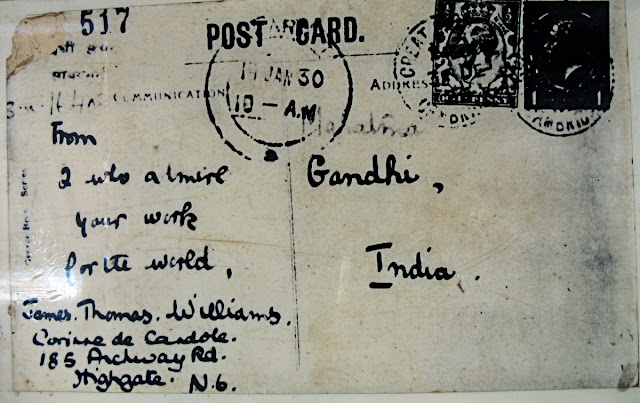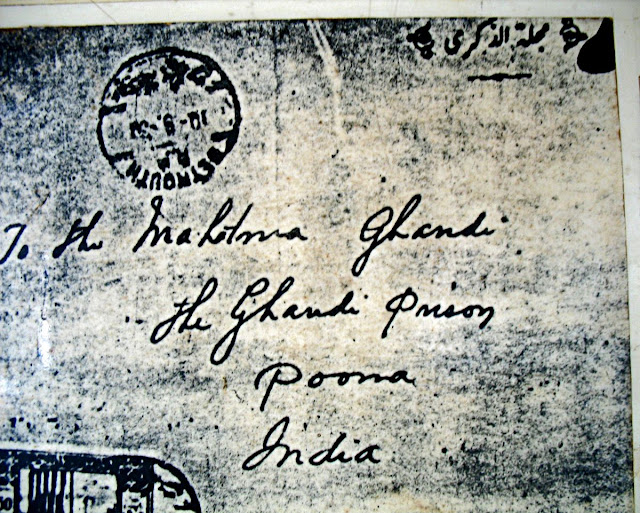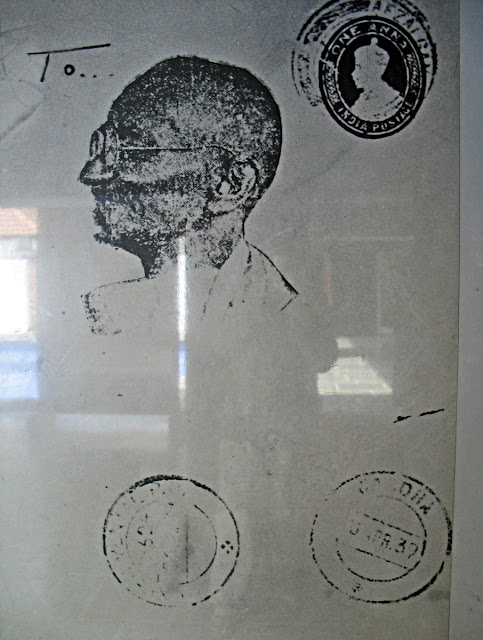Gandhi made extensive use of the printing press and railways to directly communicate with large numbers of people. To these, we may also add that other modern institution: the post office. A prolific letter writer, Gandhi engaged with a vast network of correspondents scattered across the world. Around 33,000 of these letters are reproduced in the Collected Works of Mahatma Gandhi. In turn, he too received a large volume of mail. Gandhi published some letters that were critical of his views or actions as purvapaksha — the opponent’s arguments — in his columns. Some others are available in anthologies of Gandhi’s correspondence or reproduced in books. But the bulk of these letters are only available in archival collections.
Letters to Gandhi are the first two of a proposed series comprising the letters written to Gandhi in English, available at the archives at Sabarmati Ashram in Ahmedabad. While the literature on Gandhi is extensive, Letters to Gandhi offer us glimpses and insights into how both well-known and ordinary individuals saw Gandhi in his lifetime. Without rehearsing Gandhi’s biography in this period, in this review I will highlight some of the salient aspects of his life and times as reflected in these volumes.
It was in [South Africa’s] alien, hostile, and rapidly shifting context of legal and political quicksand that the young and inexperienced Gandhi entered the public arena.
Chronologically arranged, except for one letter from Gandhi’s time in London, the volumes cover the period from his arrival in South Africa at the high noon of Empire in 1893 to 1910, the year in which the political and military contestation between the British and the Boers came to an end with the formation of the Union of South Africa. Indentured Indians began arriving in the region from the 1860s onwards. Sometime later came the ‘passengers’ who paid their way to South Africa to work primarily as traders and merchants. Indian lives in the four provinces — Natal and the Cape Colony under British control, Transvaal and the Orange Free State under the Boers (of Dutch extraction) — were governed by a complicated, often bewildering, and increasingly restrictive and coercive set of laws and rules.

It was in this alien, hostile, and rapidly shifting context of legal and political quicksand that the young and inexperienced Gandhi entered the public arena. Gandhi’s presence in South Africa had been noticed within days of his arrival, thanks to his refusal to remove his turban in a court. But the range of letters in 1895 points to the rapidity with which Gandhi came to be the focus of Indian attention.
Gandhi’s early method of writing to the newspapers, lobbying officials, and presenting petitions was a tepid affair. But it reflected the ground realities of the time.
Compared with the militancy of the satyagrahi he would become, Gandhi’s early method of writing to the newspapers, lobbying officials, and presenting petitions was a tepid affair. But it reflected the ground realities of the time. In South Africa at the sufferance of the colonisers, many Indians saw themselves as sojourners and argued for their rights as subjects of Empire. In recent decades, some scholars have been critical of this attitude and have charged Gandhi with promoting the class interests of the richer Indian merchants and indifference to the lives of indentured workers and racism towards native Africans. Undoubtedly the class differences between the merchants and labourers were real. But as several letters in the first volume attest, the challenges of organising a migrant community scattered across the land and governed by a punitive legal code were extraordinary. A clutch of letters from a leading Indian firm, Mohammad Cassim Camroodeen and Co., bemoaned the difficulty of raising funds and achieving unity of purpose even amongst the merchants themselves. It is under such unfavourable circumstances that the Natal Indian Congress was created.
Although substantial political success remained elusive for years, Gandhi managed to ameliorate the lives of indentured labourers in small but valuable measures.
In 1895, legislative measures to disenfranchise Indians were introduced. Gandhi’s pamphlet on the issue was appreciated by the progressive missionary William Cullen Wilcox for “the masterly way that you have treated the subject”. (27 December 1895; 1:66–70.) In the context of a new official distinction between Indian and native rights, Wilcox also made a striking observation that “this country belonged to the natives from whom it was taken without their consent, it certainly seems no more than fair that they should have some sort of representation in the legislation of the country” and asked Gandhi to take the same position. During this period, Gandhi was also being repeatedly urged by influential Britons like the veteran Indian civil servant William Hunter to argue that “the British Indian subjects in South Africa are, alike in our own Colonies and in independent friendly States, being deprived of their status as British subjects guaranteed to them by the Sovereign and the British Parliament.” (13 May 1896; 1: 101–102.) The contentious debate on Gandhi’s politics in this period has centred around the later position that was adopted.
Although substantial political success remained elusive for years, Gandhi managed to ameliorate the lives of indentured labourers in small but valuable measures. This was immediately noticed and many approached him for help. Madurai, an indentured domestic worker, movingly narrated the story of his ill-treatment and coercion, with an ever-present threat of arbitrary imprisonment. (7 November 1895; 1: 55–57.) A. Brekley, an Anglo-Indian supervisor with direct experience of the treatment of Indians, appealed to Gandhi to do something to “remedy their grievances”. (27 June 1901; 2:17.) I “have seen so much cruelty”, he noted, “that it really behoves me to speak […] These unfortunates are unable to air their grievances knowing full well, that were they to do so, […] they would be marked men and for every little offence would be severely dealt with.” Gandhi even received requests for help from Rhodesia.

The sense of helplessness of these years may be contrasted with the satyagrahi spirit that many had developed in later years. When some Tamil campaigners were discharged from prison in 1909, they were “thin and weak, some of them were nothing but skin and bone. But in spite of this suffering that they have to undergo, they are all prepared to go back to gaol today,” wrote C. K. T. Naidoo, one of the first satyagrahis in South Africa. (4 October 1909; 2: 253–254.)
Along with Indian approbation, Gandhi’s efforts also evoked the hostility of a section of the white population. In a well-known incident in January 1897, upon disembarking from a ship in Durban, Gandhi was attacked and nearly killed by a white mob. Two remarkable documents in Letters to Gandhi are individual missives from Chief Constable Ritch Alexander and his wife Jane, both of whom had independently played crucial roles in saving Gandhi’s life. The Alexanders felt ashamed at the behaviour of their fellow whites and did not wish to accept the expensive gifts presented by a grateful Indian community. But they acceded as returning the gifts was, as Jane Alexander put it, “adding another insult, to the many you have had to endure since your return.” (22 January 1897; 1: 117.)
“Socrates was poisoned with the Hemlock cup […] Reformers have ever been martyrs.” Such heroic imagery would be invoked many a time in Gandhi’s life.
Gandhi was himself unsentimental in such matters and could act upon his convictions in a ruthless manner. When departing from South Africa in 1901, the Gandhis were presented many gifts including expensive jewellery. As is well known, Gandhi returned the jewels to the Natal Indian Congress against his wife Kastur’s wishes. This greatly upset his colleague Parsee Rustomjee who threatened to sever his ties with the organisation. Rustomjee pointed out that Gandhi’s stubborn determination to return the gifts “cannot but lead to misconstruction of motives in the donor as in the recipient.” (19 October 1901;2: 30–33.) Gandhi remained unmoved. In the event, Rustomjee did not carry out his threat and proved to be a stalwart of future campaigns.
The Durban attack greatly enhanced Gandhi’s prestige amongst Indians as well as English sympathisers. One of them, W. J. Irons, wrote: “All honour that you should have received blows and bruises in the cause of humanity and righteousness. Socrates was poisoned with the Hemlock cup […] Reformers have ever been martyrs.” (26 February 1897; 1: 139–143.) Such heroic imagery would be invoked many a time in Gandhi’s life. Thus, when Gandhi departed under onerous circumstances for the Second Round Table Conference in London in 1931, the Gujarati poet Jhaverchand Meghani likened Gandhi’s efforts to that of Shiva drinking up the poison that arose out of the churning of the oceans.
The second volume covers a crucial period when a politically unified South Africa was created, increasingly onerous restrictions were imposed on Indians, and satyagraha was born. Gandhi’s political instincts and philosophical outlook underwent a dramatic and durable change. Arguably, the events of the singular year of 1906 and Gandhi’s evolution combined within him in an altogether radical fashion. Unfortunately, there is little material that sheds light on any of these salient aspects of Gandhi’s life. Similarly, there is nothing or very little on Gandhi’s engagement with Christianity and examination of his Hindu heritage, his relationships with friendly Britons, the founding of the settlement at Phoenix and the journal Indian Opinion, or the complicated arrangements of his family life.
Ampthill urged Gandhi to adopt a moderate position so as to persuade officials of the reasonableness of Indian demands. But the officials were uninterested.
Throughout, Gandhi established and maintained close connections with India’s political leaders and colonial officials in England. In the period under review, legislation in the provinces of South Africa had to be ratified by Britain. By mobilising public opinion in India and lobbying influential British figures, Gandhi sought to get officials in London to overrule their intransigent South African counterparts. However, that marginal shield was to disappear in 1910 with the unification of South Africa as an independent political entity. In 1909, as the final touches were begin applied to the unification process, Gandhi and a colleague travelled to London to lobby for the Indian cause. While we have little from a similar trip Gandhi made in 1906, there are some interesting entries from 1909. These letters tell us much about colonial politics in that period, the nature of which Gandhi would decisively transform a decade later with the Rowlatt satyagraha.
A key colonial official sympathetic to Indians in Transvaal was Lord Ampthill, who had served in India in various positions including as governor of Madras. Ampthill argued against the measures undertaken to strip Indians of their nominal rights in South Africa and also refuted charges that Gandhi was sponsored by ‘extremists’ in India. (This was a reference to contemporary events: Gandhi’s London visit was bookended by Madanlal Dhingra’s assassination of a British official in London and an unsuccessful attempt to assassinate Viceroy Minto in Ahmedabad.) In several letters, Ampthill urged Gandhi to adopt a moderate position so as to persuade officials of the reasonableness of Indian demands. But the officials were uninterested and sought to run the clock down till unification when the problem would be out of British hands. Moreover, as a despairing Ampthill noted “the intense preoccupation of the Government in the critical fortunes of their party at the present moment” precluded any attention to the travails of Indians in Transvaal. (17 September 1909; 2:247–248.)

In addition to a single item from the venerable Leo Tolstoy, the other important letters from this period are from one of Gandhi’s most intimate associates of the time, Henry Polak. While Gandhi was lobbying in London, Polak had been dispatched to India to canvass its political leaders on behalf of the Transvaal Indians. Across the two volumes, it is only in Polak’s letters that we see a tone of informality, including one missive that began with the salutation “My dear Bhai”. (4 September 1909; 2: 233–235.) Another letter reminds us that Gandhi’s confreres in his spiritual quest in this period were not fellow Indians, but a small group of Westerners: “Yours is splendid patience. I envy you. I see more and more the beauty of the Gita teaching. Act and don't worry about results. But I see more and more how difficult it is to do this, and admire the man who can!” (10 September 1909; 2: 238–241.)
Forged in the struggle in South Africa, Gandhi’s approach to spirituality and politics and his life-long championing of Hindu-Muslim unity would have epochal ramifications in India.
Reacting to the separate Hindu and Muslim political campaigns underway in India, Polak noted that the “beauty of our question is that it is one in regard to which all sections of the community can and do unite.” (7 October 1909; 2: 256–261.) Polak argued that “we are doing a national service”. While the Englishman’s identification with the Indian cause is interesting in itself, we can also see crucial elements of Gandhi’s worldview reflected in Polak’s letters. Forged in the struggle in South Africa, Gandhi’s approach to spirituality and politics and his life-long championing of Hindu-Muslim unity would have epochal ramifications in India.
Taken together, the volumes offer us vignettes on Gandhi’s rapid rise in the public sphere that is followed by the demands of dogged and patient work in the face of overwhelming odds and a lack of significant success. A series of volumes of Letters to Gandhi will be a useful and convenient resource for individuals interested in tracing out a fine-grained texture of Gandhi’s life. For sure, letters from a later era will afford a richer narrative for both Gandhi’s admirers and detractors, and everyone in between. The editors provide useful annotation, but a basic chronology covering the period of the volume would have helped readers find their bearings. It is hoped that the many typographic and other errors in the present volumes would be avoided.
Postscript: The enormous and ever-growing body of writing on Gandhi owes much to the exertions of numerous archivists and individuals. The availability of primary material from the South Africa period at Sabarmati is primarily due to Gandhi’s nephew Chagganlal Gandhi, who was instrumental in bringing it to India and ensuring its preservation. The current form of the archives at Sabarmati Ashram is owed to C. B. Dalal and Amrut Modi. One may add that in recent times newer technological interventions are available. However, there is an urgent need for a wider and considered debate on the reproduction of primary material and its long-term implications for the archives themselves, especially in our deeply divided times.
The photos in the text are from Nita Jatar Kulkarni's blog.










